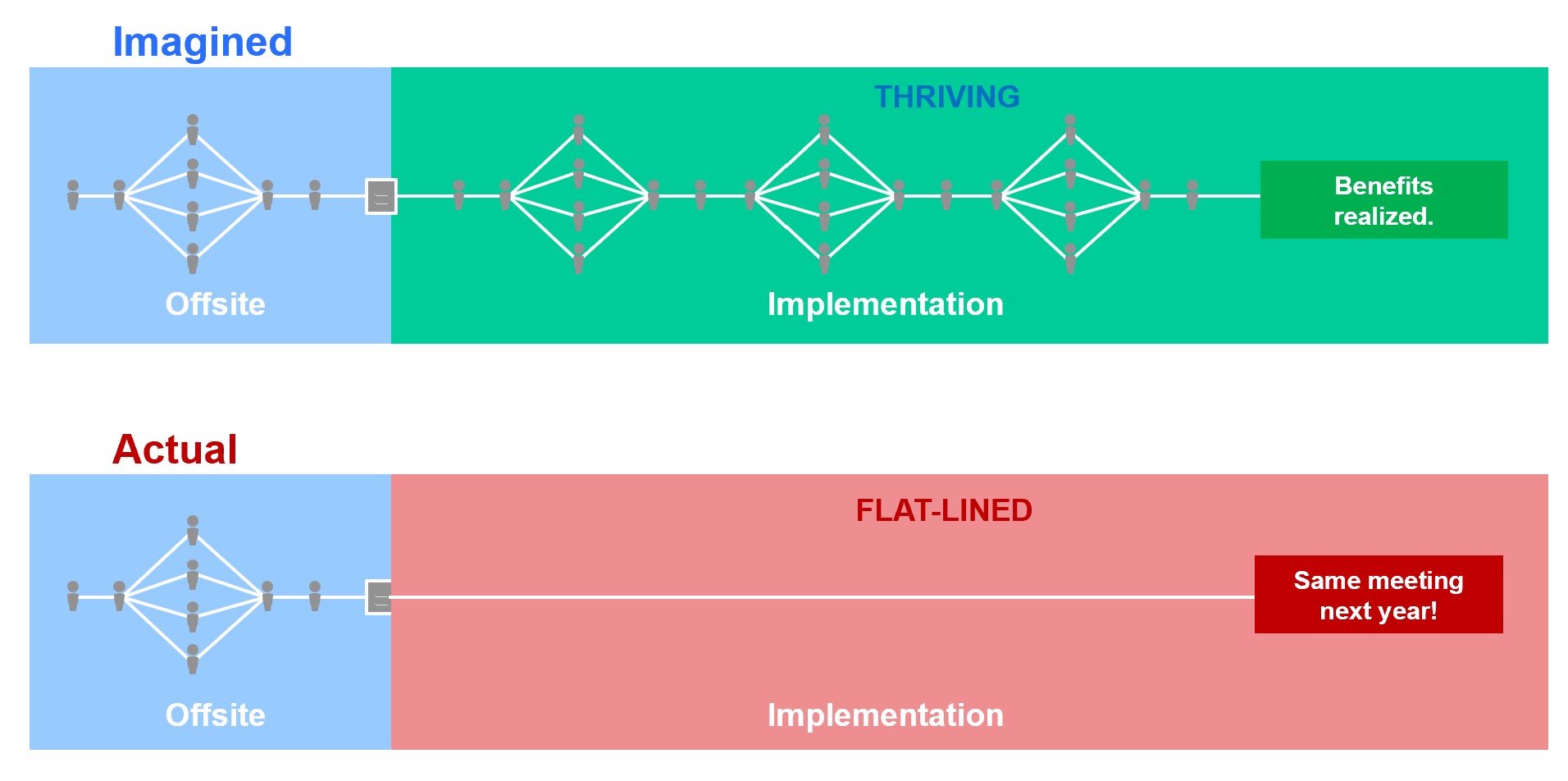BACKGROUND
Many leaders convene their top team offsite annually to set the agenda for what to do differently in the coming year. The team comes up with an impressive list of things to do and returns to the frontline eager to get on with new initiatives only to be swamped by the press of the day-to-day. A year later they meet offsite again and, sadly, often come up wtih the same list of initiatives.

Follow the steps below for far better results!
COLLECT DATA
For the most important initiative(s), survey the top team and ask each:
-
To describe the current state; that is: how things are today.
-
What really good things happen if we change and what really bad things happen if we do not?
-
To describe how things would be in the future if their ideal changes were successfully implemented.
-
What needs to be done in order to get from where things are today to where things would ideally be next?
-
What will make it hard to do what needs to be done in order to get from today to the targeted next state?
Collect responses and review with the leader. Look for and discuss fully any points the leader finds confusing or surprising.
Convene an offsite with the leader and the leadership team to review collected data and to reach consensus on each of the five topics: CURRENT STATE, CASE FOR CHANGE, TARGET STATE, WHAT MUST BE DONE, BARRIERS.
At the offsite, reveal survey responses for review with participants one section at a time in the order above. Highlight responses that are the same or similar thereby indicating progress towards consensus.
INITIATIVE CHANGE FRAMEWORK
The Initiative Change Framework Template is a way to visualize and store a clear and compelling case for an initiative. Iterate on each section with the team until all members agree on entries for each.
Start by guiding the group to spend ~20-40 minutes on each of these three sections in this order:
- CURRENT STATE: How things are today
- CASE FOR CHANGE: Why things need to change
- TARGET STATE: How things would be if the desired change is implemented.
For each section in turn, the leader and facilitator work colaboratively to motivate participants to share their thinking openly, fully, and honestly in a relentless quest for clarity and alignment.
After a break, perhaps a lunch or dinner, reconvene the group to reach consenses on:
- ACTIONS: What must be done
- BARRIERS: What will make doing what must be done difficult.
A well formulated Initiative Change Framework tells a story about where things are, why they need to change, how things would be if the intended change occurred and what must be done to get from here to there in a way that is rational, compelling, and that flows smoothly from the present through to the future.
Management offsites are known to produce a list of initiatives after intense effort and exhilarating breakthroughs. A list without context, however, fails to reveal the motivation and importance behind each initiative which makes it difficult to communicate and next to impossible to muster the energy, resources, and commitment beyond the session needed to implement them.
INITIATIVE-to-ACTION
Preparing a Change Framework instead of just a list helps, but even still, far too often, the same initiatives are listed again at the next annual offsite with little if any progress simply because no one was assigned to drive action, and resources were never allocated, to implement them.
Upon reaching concesnus on the Initaitive Change Framework, the group is likely to feel drained and accomplished. While it is important to praise the group for its good work, there is more to be done. All their good work may have been for naught unless one more step is taken.
After the list of actions is developed and before ending the offsite, the leader assigns each team member to:
-
Take ~20-minutes to fill out a draft Initiative-to-Action Template for one specific initiative, preferably one the leader would like the team member to sponsor.
-
Lead the group in a brief discussion about the assigned initiative.
Each team member, in turn, briefs the group on their initiative using the filled out Initiative-to-Action Template. As each speaks, the rest of the leadership team adopts the mindset of close-adviser and on the same team as the one speaking. Their objective is to ensure that the key points from the group’s work are captured so that the best thinking of the group is at hand and in mind as efforts to progress with the initiative proceed following the offsite.
Filling out and briefing the Initiative-to-Action form launches the governance process and slips a leadership team member into the role of the initiative’s Executive Sponsor and on-the-hook to make progress on behalf of the group. As such, the team member becomes accountable to the group for progress on their initiative. Motivation and commitment soar and the odds of making progress go up. Over the ensuing performance period, the leader calls on each team member at some point to brief the group on how their initiative is progressing.
SUMMARY
The game changes when everyone in the group shares the same clarity about every segment of the Initaitive Change Framework and when someone in the group is assigned to guide, govern, and report on progress. So doing ensures that taking actions to achieve the target state is not a side job to be done if time permits. It becomes an essential assignment of the sponsors role.
Some may ask if it is important to follow these steps for every initiative. The answer is that these steps apply only to important initiatives … but then, if an initiative is not important, why is it even on the list?
SEE ALSO
CASE EXAMPLES
Stellar Solutions – The New CEO built trust and commitment from her team supported by the IntelliVen Initiative Launch Process to frame what needed to be done, by whom, and when, thereby turning an Initiative on a list to Action. The plan worked and a year later the team is using the same process to launch their next most important initiative.
Hawaiian Airlines – New CEO and top team of six were coming out of bankruptcy with an uncertain future. The company went on to become the U.S. industry’s leading airline for operational performance, has delivered the highest levels of customer service and has been one of the most financially successful U.S. carriers.
Gemcom – PE-owned software firm serving precious metal mining companies; CEO and top team of 19 from around the world, adding a new services offering; grew revenue by ~100% and EBITDA >40%. Achieved 5-year plan in two years and sold for a high premium.
Compusearch – PE-owned software firm CEO and top team of 15; adding new offerings and entering new markets; grew from $15M to $135M with EBITDA > 40%
Softonic – Largest international software purchasing platform; based in Spain; new CEO and top team of 6; led the transition to new sales model; found IntelliVen by searching the web for best strategy offsite program
Volpe Transportation Center – Helped leaders of a team of scientists lay the groundwork for working collaboratively across divisions to pursue initiatives for new offerings beyond the scope of individual units
American Management System – Used by EVP and top team of 15 to grow Finance Industry credit management system unit from $20M to $200M operating around the world
Touchstone – Used with government agency leaders to drive strategic initiatives in DHS, NOAA, Girl Scouts, Washington Hospital, among many others
THRUUE – Used with health care and senior living providers
Acquisition Solutions – Used with government agencies to advance acquisition and procurement processes to save billions of dollars; e.g., at FEMA/FIMA
RescueSF – Used with 50 leaders of stakeholder groups (healthcare, city officials, real estate development, religious groups, etc.) to land on initiatives they could do collectively that were not possible to do on their own. Massive impact on helping the unhoused has followed.






